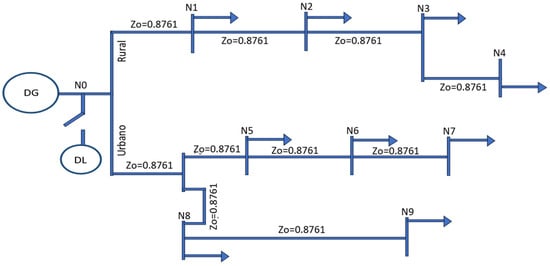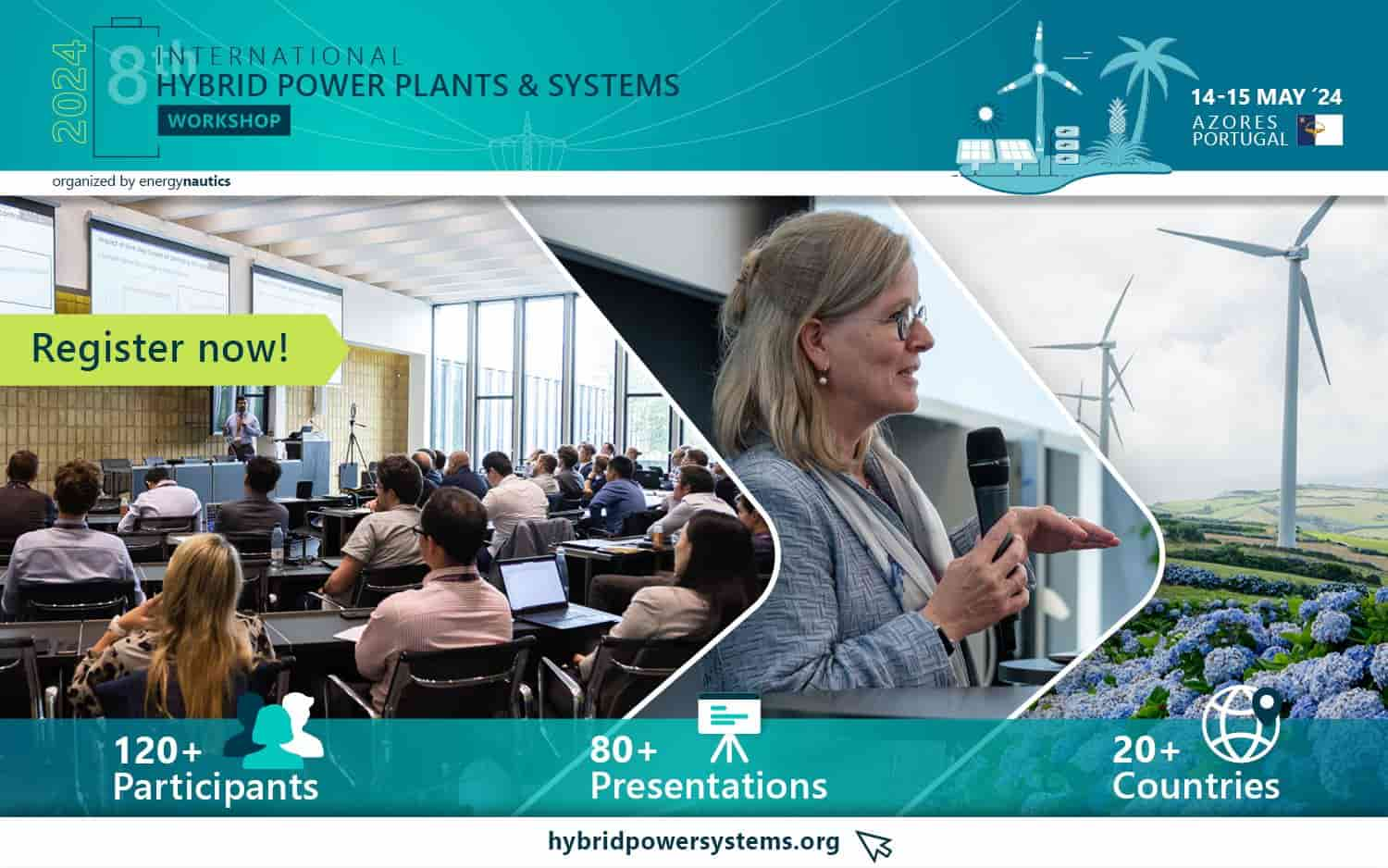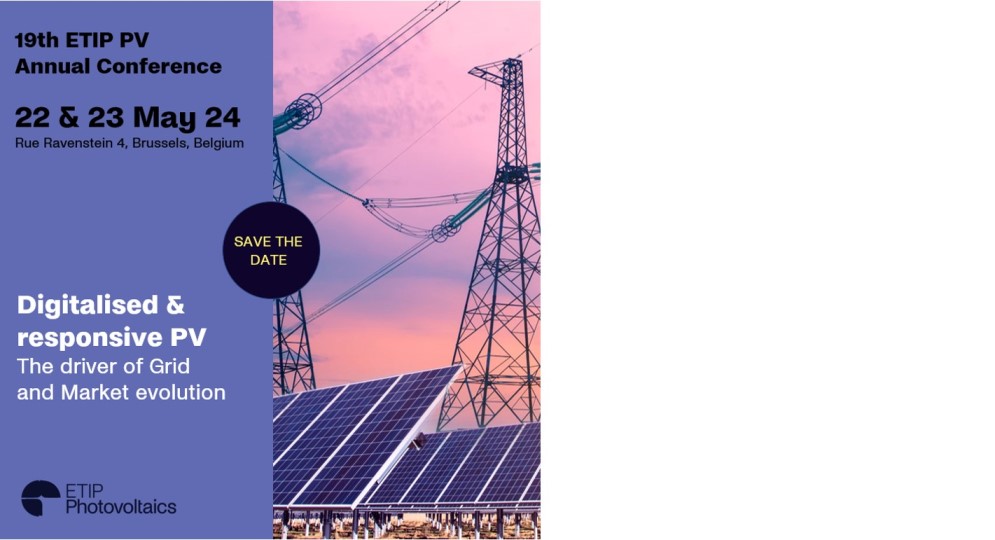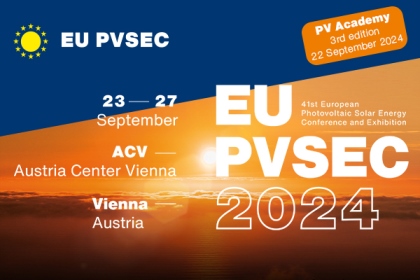Journal Description
Solar
Solar
is an international, peer-reviewed, open access journal on all aspects of solar energy and photovoltaic systems published quarterly online by MDPI.
- Open Access— free for readers, with article processing charges (APC) paid by authors or their institutions.
- Rapid Publication: manuscripts are peer-reviewed and a first decision is provided to authors approximately 16.9 days after submission; acceptance to publication is undertaken in 5.7 days (median values for papers published in this journal in the second half of 2023).
- Recognition of Reviewers: APC discount vouchers, optional signed peer review and reviewer names are published annually in the journal.
- Solar is a companion journal of Energies.
Latest Articles
Optimal Design of a Hybrid Solar–Battery–Diesel System: A Case Study of Galapagos Islands
Solar 2024, 4(2), 232-245; https://doi.org/10.3390/solar4020011 - 06 Apr 2024
Abstract
In this study, the sizing problem of hybrid diesel–photovoltaic–battery systems was determined using a particle swarm optimization approach. The goal was to optimize the number of solar panels and batteries that could be installed to reduce the overall cost of an isolated grid
[...] Read more.
In this study, the sizing problem of hybrid diesel–photovoltaic–battery systems was determined using a particle swarm optimization approach. The goal was to optimize the number of solar panels and batteries that could be installed to reduce the overall cost of an isolated grid system, originally powered by diesel generators, located on Isabela Island in the Galapagos, Ecuador. In this study, real solar radiation and temperature profiles were used, as well as the load demand and electrical distribution system relative to this island. The results reveal that the total cost for the proposed approach is lower as it reaches the global optimal solution. It also highlights the advantage of a hybrid diesel–photovoltaic–battery (DG-PV-BAT) system compared to conventional systems operated exclusively by diesel generators (DGs) and systems made up of DGs and PV panels; compared to them, a reduction in diesel consumption and total cost (71% and 56%, respectively) is achieved. The DG-PV-BAT system also considerably improves environmental factors and the quality of the power line. This study demonstrates the advantages of hybridizing systems isolated from the network through the proposed approach.
Full article
(This article belongs to the Special Issue Power Electronics Architectures and Associated Control for Efficient and Reliable Solar PV Systems)
►
Show Figures
Open AccessArticle
Exploring the Feasibility and Performance of Perovskite/Antimony Selenide Four-Terminal Tandem Solar Cells
by
Harigovind Menon, Al Amin, Xiaomeng Duan, S. N. Vijayaraghavan, Jacob Wall, Wenjun Xiang, Kausar Ali Khawaja and Feng Yan
Solar 2024, 4(2), 222-231; https://doi.org/10.3390/solar4020010 - 03 Apr 2024
Abstract
The tandem solar cell presents a potential solution to surpass the Shockley–Queisser limit observed in single-junction solar cells. However, creating a tandem device that is both cost-effective and highly efficient poses a significant challenge. In this study, we present proof of concept for
[...] Read more.
The tandem solar cell presents a potential solution to surpass the Shockley–Queisser limit observed in single-junction solar cells. However, creating a tandem device that is both cost-effective and highly efficient poses a significant challenge. In this study, we present proof of concept for a four-terminal (4T) tandem solar cell utilizing a wide bandgap (1.6–1.8 eV) perovskite top cell and a narrow bandgap (1.2 eV) antimony selenide (Sb2Se3) bottom cell. Using a one-dimensional (1D) solar cell capacitance simulator (SCAPS), our calculations indicate the feasibility of this architecture, projecting a simulated device performance of 23% for the perovskite/Sb2Se3 4T tandem device. To validate this, we fabricated two wide bandgap semitransparent perovskite cells with bandgaps of 1.6 eV and 1.77 eV, respectively. These were then mechanically stacked with a narrow bandgap antimony selenide (1.2 eV) to create a tandem structure, resulting in experimental efficiencies exceeding 15%. The obtained results demonstrate promising device performance, showcasing the potential of combining perovskite top cells with the emerging, earth-abundant antimony selenide thin film solar technology to enhance overall device efficiency.
Full article
(This article belongs to the Special Issue The Forth-Coming Era of Photovoltaic Technologies: Hybrid Organic-Inorganic Solar Cells)
►▼
Show Figures

Figure 1
Open AccessArticle
A Quantitative Analysis of the Need for High Conversion Efficiency PV Technologies in Carbon Mitigation Strategies
by
Kenneth M. Hughes and Chris C. Phillips
Solar 2024, 4(2), 209-221; https://doi.org/10.3390/solar4020009 - 26 Mar 2024
Abstract
We consider the restrictions on photovoltaic (PV) capacity that are caused by limitations on where panels can be sited and find quantitative evidence for the need for high efficiencies. We define 15% of the UK’s energy consumption as a “significant” contribution and, with
[...] Read more.
We consider the restrictions on photovoltaic (PV) capacity that are caused by limitations on where panels can be sited and find quantitative evidence for the need for high efficiencies. We define 15% of the UK’s energy consumption as a “significant” contribution and, with London as an exemplar, we perform an idealised calculation that makes the most optimistic possible assumptions about the capabilities of future PV technologies and use published surveys on energy usage, dwelling type and insolation. We find that covering every UK domestic roof with the highest power conversion efficiency (PCE) solar panels currently commercially available could produce up to 9% of the UK’s energy. A 15% contribution would require PV technologies with >37% PCE, more than the theoretical Shockley–Queisser limit. Replacing the idealising assumptions with more realistic estimates increases this by 2–3 times. Alternatively, a solar farm using the currently available PCEs would require a politically challenging ~1200 km2 of new land, roughly the area of Greater London, for this 15% contribution. We conclude that PCEs must be driven higher than even the Shockley–Queisser limit for PV to play a significant part in carbon mitigation.
Full article
(This article belongs to the Special Issue Power Electronics Architectures and Associated Control for Efficient and Reliable Solar PV Systems)
►▼
Show Figures

Graphical abstract
Open AccessArticle
A Novel Statistical Framework for Optimal Sizing of Grid-Connected Photovoltaic–Battery Systems for Peak Demand Reduction to Flatten Daily Load Profiles
by
Reza Nematirad, Anil Pahwa and Balasubramaniam Natarajan
Solar 2024, 4(1), 179-208; https://doi.org/10.3390/solar4010008 - 14 Mar 2024
Cited by 1
Abstract
Integrating photovoltaic (PV) systems plays a pivotal role in the global shift toward renewable energy, offering significant environmental benefits. However, the PV installation should provide financial benefits for the utilities. Considering that the utility companies often incur costs for both energy and peak
[...] Read more.
Integrating photovoltaic (PV) systems plays a pivotal role in the global shift toward renewable energy, offering significant environmental benefits. However, the PV installation should provide financial benefits for the utilities. Considering that the utility companies often incur costs for both energy and peak demand, PV installations should aim to reduce both energy and peak demand charges. Although PV systems can reduce energy needs during the day, their effectiveness in reducing peak demand, particularly in the early morning and late evening, is limited, as PV generation is zero or negligible at those times. To address this limitation, battery storage systems are utilized for storing energy during off-peak hours and releasing it during peak times. However, finding the optimal size of PV and the accompanying battery remains a challenge. While valuable optimization models have been developed to determine the optimal size of PV–battery systems, a certain gap remains where peak demand reduction has not been sufficiently addressed in the optimization process. Recognizing this gap, this study proposes a novel statistical model to optimize PV–battery system size for peak demand reduction. The model aims to flatten 95% of daily peak demands up to a certain demand threshold, ensuring consistent energy supply and financial benefit for utility companies. A straightforward and effective search methodology is employed to determine the optimal system sizes. Additionally, the model’s effectiveness is rigorously tested through a modified Monte Carlo simulation coupled with time series clustering to generate various scenarios to assess performance under different conditions. The results indicate that the optimal PV–battery system successfully flattens 95% of daily peak demand with a selected threshold of 2000 kW, yielding a financial benefit of USD 812,648 over 20 years.
Full article
(This article belongs to the Topic Smart Solar Energy Systems)
►▼
Show Figures
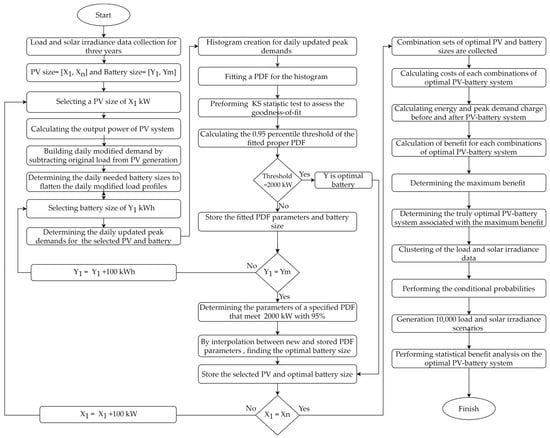
Figure 1
Open AccessArticle
Development of n-Type, Passivating Nanocrystalline Silicon Oxide Films via Plasma-Enhanced Chemical Vapor Deposition
by
Gurleen Kaur, Antonio J. Olivares and Pere Roca i Cabarrocas
Solar 2024, 4(1), 162-178; https://doi.org/10.3390/solar4010007 - 11 Mar 2024
Abstract
Nanocrystalline silicon oxide (nc-SiOx:H) is a multipurpose material with varied applications in solar cells as a transparent front contact, intermediate reflector, back reflector layer, and even tunnel layer for passivating contacts, owing to the easy tailoring of its optical properties. In this work,
[...] Read more.
Nanocrystalline silicon oxide (nc-SiOx:H) is a multipurpose material with varied applications in solar cells as a transparent front contact, intermediate reflector, back reflector layer, and even tunnel layer for passivating contacts, owing to the easy tailoring of its optical properties. In this work, we systematically investigate the influence of the gas mixture (SiH4, CO2, PH3, and H2), RF power, and process pressure on the optical, structural, and passivation properties of thin n-type nc-SiOx:H films prepared in an industrial, high-throughput, plasma-enhanced chemical vapor deposition (PECVD) reactor. We provide a detailed description of the n-type nc-SiOx:H material development using various structural and optical characterization techniques (scanning electron microscopy (SEM), energy dispersive X-ray (EDX), Raman spectroscopy, and spectroscopic ellipsometry) with a focus on the relationship between the material properties and the passivation they provide to n-type c-Si wafers characterized by their effective carrier lifetime (τeff). Furthermore, we also outline the parameters to be kept in mind while developing different n-type nc-SiOx:H layers for different solar cell applications. We report a tunable optical gap (1.8–2.3 eV) for our n-type nc-SiOx:H films as well as excellent passivation properties with a τeff of up to 4.1 ms (implied open-circuit voltage (iVoc)~715 mV) before annealing. Oxygen content plays an important role in determining the crystallinity and hence passivation quality of the deposited nanocrystalline silicon oxide films.
Full article
(This article belongs to the Special Issue Developments in Perovskite Solar Cells)
►▼
Show Figures
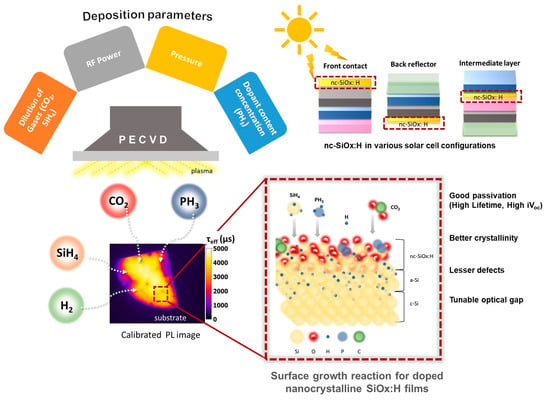
Graphical abstract
Open AccessReview
Immersive Learning in Photovoltaic Energy Education: A Comprehensive Review of Virtual Reality Applications
by
Noor Alqallaf and Rami Ghannam
Solar 2024, 4(1), 136-161; https://doi.org/10.3390/solar4010006 - 04 Mar 2024
Abstract
►▼
Show Figures
This paper presents a comprehensive and systematic review of virtual reality (VR) as an innovative educational tool specifically for solar photovoltaic energy systems. VR technology, with its immersive and interactive capabilities, offers a unique platform for in-depth learning and practical training in the
[...] Read more.
This paper presents a comprehensive and systematic review of virtual reality (VR) as an innovative educational tool specifically for solar photovoltaic energy systems. VR technology, with its immersive and interactive capabilities, offers a unique platform for in-depth learning and practical training in the field of solar energy. The use of VR in this context not only enhances the understanding of solar photovoltaic (PV) systems but also provides a hands-on experience that is crucial for developing the necessary skills in this rapidly evolving field. Among the 6814 articles initially identified, this systematic review specifically examined 15 articles that focused on the application of VR in PV education. These selected articles demonstrate VR’s ability to accurately simulate real-world environments and scenarios related to solar energy, providing an in-depth exploration of its practical applications in this field. By offering a realistic and detailed exploration of PV systems, VR enables learners to gain a deeper understanding of harnessing, managing and using such a vast energy resource. The paper further discusses the implications of employing VR in educational settings, highlighting its potential to change the way solar energy professionals are trained, thereby contributing significantly to the acceleration of photovoltaic technology adoption and its integration into sustainable energy solutions.
Full article
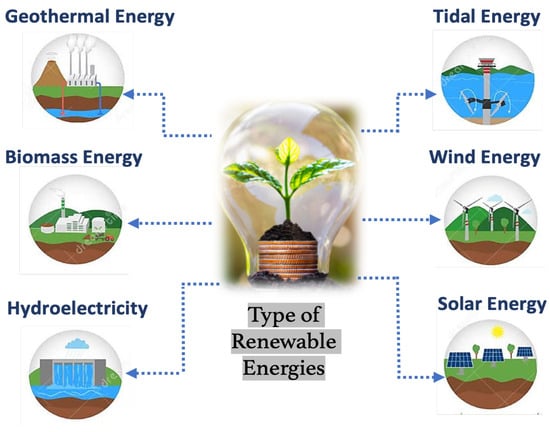
Figure 1
Open AccessReview
A Review of Solar Forecasting Techniques and the Role of Artificial Intelligence
by
Khadija Barhmi, Chris Heynen, Sara Golroodbari and Wilfried van Sark
Solar 2024, 4(1), 99-135; https://doi.org/10.3390/solar4010005 - 22 Feb 2024
Cited by 1
Abstract
Solar energy forecasting is essential for the effective integration of solar power into electricity grids and the optimal management of renewable energy resources. Distinguishing itself from the existing literature, this review study provides a nuanced contribution by centering on advancements in forecasting techniques.
[...] Read more.
Solar energy forecasting is essential for the effective integration of solar power into electricity grids and the optimal management of renewable energy resources. Distinguishing itself from the existing literature, this review study provides a nuanced contribution by centering on advancements in forecasting techniques. While preceding reviews have examined factors such as meteorological input parameters, time horizons, the preprocessing methodology, optimization, and sample size, our study uniquely delves into a diverse spectrum of time horizons, spanning ultrashort intervals (1 min to 1 h) to more extended durations (up to 24 h). This temporal diversity equips decision makers in the renewable energy sector with tools for enhanced resource allocation and refined operational planning. Our investigation highlights the prominence of Artificial Intelligence (AI) techniques, specifically focusing on Neural Networks in solar energy forecasting, and we review supervised learning, regression, ensembles, and physics-based methods. This showcases a multifaceted approach to address the intricate challenges associated with solar energy predictions. The integration of Satellite Imagery, weather predictions, and historical data further augments precision in forecasting. In assessing forecasting models, our study describes various error metrics. While the existing literature discusses the importance of metrics, our emphasis lies on the significance of standardized datasets and benchmark methods to ensure accurate evaluations and facilitate meaningful comparisons with naive forecasts. This study stands as a significant advancement in the field, fostering the development of accurate models crucial for effective renewable energy planning and emphasizing the imperative for standardization, thus addressing key gaps in the existing research landscape.
Full article
(This article belongs to the Topic Solar Forecasting and Smart Photovoltaic Systems)
►▼
Show Figures
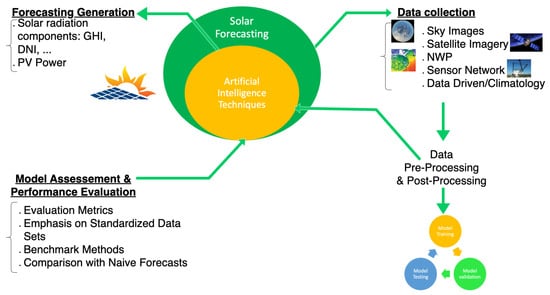
Figure 1
Open AccessArticle
Cu-Doped Sb2Se3 Thin-Film Solar Cells Based on Hybrid Pulsed Electron Deposition/Radio Frequency Magnetron Sputtering Growth Techniques
by
Roberto Jakomin, Stefano Rampino, Giulia Spaggiari, Michele Casappa, Giovanna Trevisi, Elena Del Canale, Enos Gombia, Matteo Bronzoni, Kodjo Kekeli Sossoe, Francesco Mezzadri and Francesco Pattini
Solar 2024, 4(1), 83-98; https://doi.org/10.3390/solar4010004 - 04 Feb 2024
Abstract
►▼
Show Figures
In recent years, research attention has increasingly focused on thin-film photovoltaics utilizing Sb2Se3 as an ideal absorber layer. This compound is favored due to its abundance, non-toxic nature, long-term stability, and the potential to employ various cost-effective and scalable vapor
[...] Read more.
In recent years, research attention has increasingly focused on thin-film photovoltaics utilizing Sb2Se3 as an ideal absorber layer. This compound is favored due to its abundance, non-toxic nature, long-term stability, and the potential to employ various cost-effective and scalable vapor deposition (PVD) routes. On the other hand, improving passivation, surface treatment and p-type carrier concentration is essential for developing high-performance and commercially viable Sb2Se3 solar cells. In this study, Cu-doped Sb2Se3 solar devices were fabricated using two distinct PVD techniques, pulsed electron deposition (PED) and radio frequency magnetron sputtering (RFMS). Furthermore, 5%Cu:Sb2Se3 films grown via PED exhibited high open-circuit voltages (VOC) of around 400 mV but very low short-circuit current densities (JSC). Conversely, RFMS-grown Sb2Se3 films resulted in low VOC values of around 300 mV and higher JSC. To enhance the photocurrent, we employed strategies involving a thin NaF layer to introduce controlled local doping at the back interface and a bilayer p-doped region grown sequentially using PED and RFMS. The optimized Sb2Se3 bilayer solar cell achieved a maximum efficiency of 5.25%.
Full article
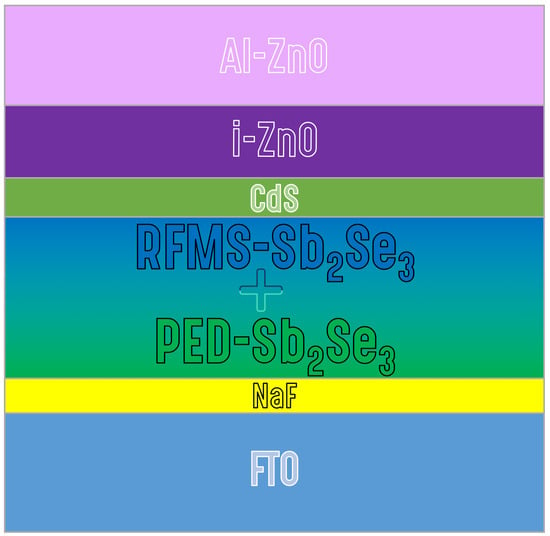
Graphical abstract
Open AccessReview
A Review of Photovoltaic Module Failure and Degradation Mechanisms: Causes and Detection Techniques
by
Hussain Al Mahdi, Paul G. Leahy, Mohammad Alghoul and Alan P. Morrison
Solar 2024, 4(1), 43-82; https://doi.org/10.3390/solar4010003 - 09 Jan 2024
Cited by 1
Abstract
With the global increase in the deployment of photovoltaic (PV) modules in recent years, the need to explore and understand their reported failure mechanisms has become crucial. Despite PV modules being considered reliable devices, failures and extreme degradations often occur. Some degradations and
[...] Read more.
With the global increase in the deployment of photovoltaic (PV) modules in recent years, the need to explore and understand their reported failure mechanisms has become crucial. Despite PV modules being considered reliable devices, failures and extreme degradations often occur. Some degradations and failures within the normal range may be minor and not cause significant harm. Others may initially be mild but can rapidly deteriorate, leading to catastrophic accidents, particularly in harsh environments. This paper conducts a state-of-the-art literature review to examine PV failures, their types, and their root causes based on the components of PV modules (from protective glass to junction box). It outlines the hazardous consequences arising from PV module failures and describes the potential damage they can bring to the PV system. The literature reveals that each component is susceptible to specific types of failure, with some components deteriorating on their own and others impacting additional PV components, leading to more severe failures. Finally, this review briefly summarises PV failure detection techniques, emphasising the significance of electrical characterisation techniques and underlining the importance of considering more electrical parameters. Most importantly, this review identifies the most prevalent degradation processes, laying the foundation for further investigation by the PV research community through modelling and experimental studies. This allows for early detection by comparing PV performance when failures or degradation occur to prevent serious progression. It is worth noting that most of the studies included in this review primarily focus on detailing failures and degradation observed in PV operations, which can be attributed to various factors, including the manufacturing process and other external influences. Hence, they provide explanations of these failure mechanisms and causes but do not extensively explore corrective actions or propose solutions based on either laboratory experiments or real-world experience. Although, within this field of study, there are corresponding studies that have designed experiments to suggest preventive measures and potential solutions, an in-depth review of those studies is beyond the scope of this paper. However, this paper, in turn, serves as a valuable resource for scholars by confining PV failures to critically evaluate available studies for preventative measures and corrective actions.
Full article
(This article belongs to the Special Issue Power Electronics Architectures and Associated Control for Efficient and Reliable Solar PV Systems)
►▼
Show Figures
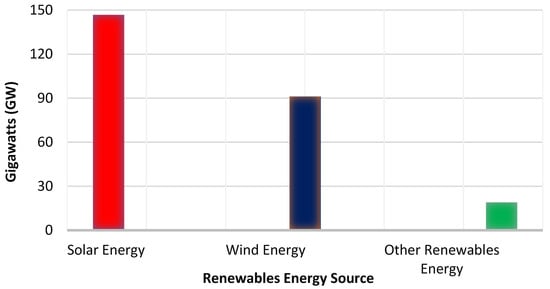
Figure 1
Open AccessReview
A Review on Solar Drying Devices: Heat Transfer, Air Movement and Type of Chambers
by
Lisete Fernandes and Pedro B. Tavares
Solar 2024, 4(1), 15-42; https://doi.org/10.3390/solar4010002 - 08 Jan 2024
Abstract
►▼
Show Figures
Food waste is one of the biggest challenges we are facing nowadays. According to the Food and Agriculture Organization (FAO) of the United Nations, approximately one-third of all food produced in the world is lost at some stage between production and consumption, totaling
[...] Read more.
Food waste is one of the biggest challenges we are facing nowadays. According to the Food and Agriculture Organization (FAO) of the United Nations, approximately one-third of all food produced in the world is lost at some stage between production and consumption, totaling 930 million tons of food per year. Meanwhile, 10.5% of humanity suffers from malnutrition, 26% are overweight and greenhouse gases derived from the food industry account for between 25 and 30% of total emissions (8 to 10% referring to food waste), exacerbating the current climate crisis. To address these concerns, there has been a growing inclination to seek alternatives to fossil fuels, including the adoption of solar energy across diverse sectors, including the food industry. Actions are needed in order to change these patterns. This review article aims to provide an overview of recent developments in the field of solar food dehydration and the types of dehydrators that have emerged. Extensive research and bibliographic analysis, including other review articles, have revealed a growing focus on investment in this area to develop solar dehydrators that are increasingly effective but as sustainable as possible.
Full article
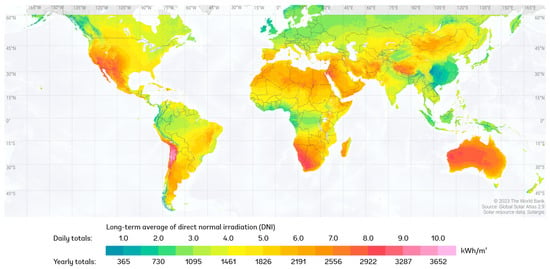
Figure 1
Open AccessArticle
Impact of Flexibility Implementation on the Control of a Solar District Heating System
by
Manuel Betancourt Schwarz, Mathilde Veyron and Marc Clausse
Solar 2024, 4(1), 1-14; https://doi.org/10.3390/solar4010001 - 27 Dec 2023
Cited by 1
Abstract
►▼
Show Figures
Renewable energy sources, distributed generation, multi-energy carriers, distributed storage, and low-temperature district heating systems, among others, are demanding a change in the way thermal networks are conceived, understood, and operated. Governments around the world are moving to increase the renewable share in energy
[...] Read more.
Renewable energy sources, distributed generation, multi-energy carriers, distributed storage, and low-temperature district heating systems, among others, are demanding a change in the way thermal networks are conceived, understood, and operated. Governments around the world are moving to increase the renewable share in energy distribution networks through legislation like the European Directive 2012/27 in Europe, and solar energy integration into district heating systems is arising as an interesting option to reduce operation costs and carbon footprint. This conveys an important investment that adds complexity to the management of thermal networks and often delays the return on investment due to the unpredictability of renewable energy sources, like solar radiation. To this end, this paper presents an optimisation methodology to aid in the operative control of an existing solar district heating system located in the northwest of France. The modelling of the system, which includes a large-scale solar field, a biomass boiler, a gas boiler, and thermal energy storage, was previously built in Dymola. The optimisation of this network was performed using MATLAB’s genetic algorithm (GA) and running the Dymola model as functional mock-up units, FMUs, using Simulink’s FMI Kit. The results show that the methodology presented here can reduce the current operation costs and improve the use of the daily storage of the DH system by a combination of mass flow control and the implementation of a flexibility function for the end-users. The cost-per-kWh was reduced by as much as 16% in a single day, and the share of heat supplied by the solar field on this day was increased by 5.22%.
Full article

Figure 1
Open AccessReview
A Survey of CNN-Based Approaches for Crack Detection in Solar PV Modules: Current Trends and Future Directions
by
Sharmarke Hassan and Mahmoud Dhimish
Solar 2023, 3(4), 663-683; https://doi.org/10.3390/solar3040036 - 01 Dec 2023
Cited by 1
Abstract
►▼
Show Figures
Detection of cracks in solar photovoltaic (PV) modules is crucial for optimal performance and long-term reliability. The development of convolutional neural networks (CNNs) has significantly improved crack detection, offering improved accuracy and efficiency over traditional methods. This paper presents a comprehensive review and
[...] Read more.
Detection of cracks in solar photovoltaic (PV) modules is crucial for optimal performance and long-term reliability. The development of convolutional neural networks (CNNs) has significantly improved crack detection, offering improved accuracy and efficiency over traditional methods. This paper presents a comprehensive review and comparative analysis of CNN-based approaches for crack detection in solar PV modules. The review discusses various CNN architectures, including custom-designed networks and pre-trained models, as well as data-augmentation techniques and ensemble learning methods. Additionally, challenges related to limited dataset sizes, generalizability across different solar panels, interpretability of CNN models, and real-time detection are discussed. The review also identifies opportunities for future research, such as the need for larger and more diverse datasets, model interpretability, and optimized computational speed. Overall, this paper serves as a valuable resource for researchers and practitioners interested in using CNNs for crack detection in solar PV modules.
Full article
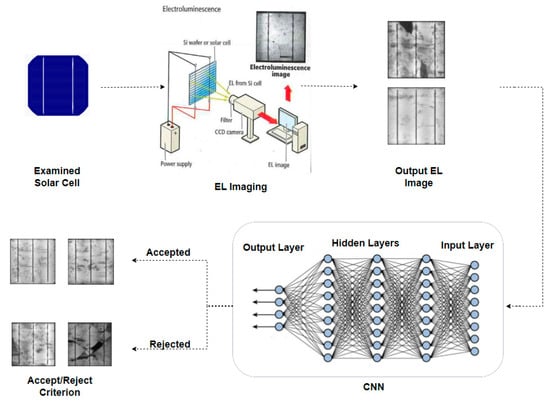
Figure 1
Open AccessArticle
Assessing the Potential of Qatari House Roofs for Solar Panel Installations: A Feasibility Survey
by
Ayed Banibaqash, Ziad Hunaiti and Maysam Abbod
Solar 2023, 3(4), 650-662; https://doi.org/10.3390/solar3040035 - 10 Nov 2023
Cited by 1
Abstract
Qatar’s ambitious Vision 2030 includes a major shift towards clean energy, and residential solar PV installation can be an obvious option, given its abundant sunlight and high power for residential cooling. Despite significant solar panel farm investment, there has been limited progress in
[...] Read more.
Qatar’s ambitious Vision 2030 includes a major shift towards clean energy, and residential solar PV installation can be an obvious option, given its abundant sunlight and high power for residential cooling. Despite significant solar panel farm investment, there has been limited progress in deploying solar panels on home roofs, and further research is needed to identify the potential for such an initiative and its impact on the country’s move towards clean energy. This field survey assesses the potential for residential rooftop solar panel installation across Qatar, considering space availability, currently utilized space, remaining space, shading, and roof type. It also provided indications of potential obstacles and shading that might affect panel sunlight exposure. The results showed that there is significant potential for installing solar panels on Qatari homes, which could contribute to a considerable portion of the energy consumed by households during peak usage periods, particularly in the summer months. Moreover, excess energy generated could be exported to other countries with high demand during periods of low demand in Qatar. The study’s findings complement previous research efforts and provide insights for policymakers and stakeholders to develop strategies that endorse the vision for 2030 and promote the transition towards clean energy in Qatar.
Full article
(This article belongs to the Topic Advances in Renewable Energy and Energy Storage)
►▼
Show Figures
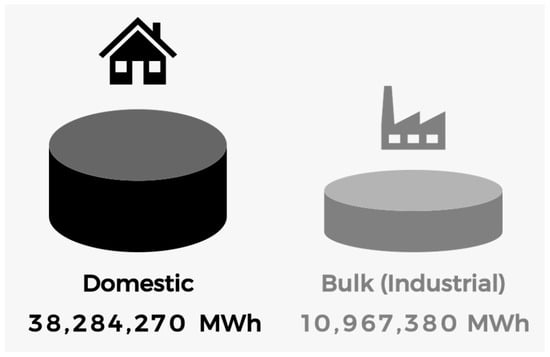
Figure 1
Open AccessReview
Overview of Energy Systems in Africa: A Comprehensive Review
by
Michael M. Santos, Ana Teresa Vaz Ferreira and João C. G. Lanzinha
Solar 2023, 3(4), 638-649; https://doi.org/10.3390/solar3040034 - 08 Nov 2023
Abstract
►▼
Show Figures
Africa has abundant solar resources but only 2% of its current capacity is generated from renewable sources. Photovoltaics (PV) offer sustainable, decentralized electricity access to meet development needs. This review synthesizes the recent literature on PV in Africa, with a focus on Mozambique.
[...] Read more.
Africa has abundant solar resources but only 2% of its current capacity is generated from renewable sources. Photovoltaics (PV) offer sustainable, decentralized electricity access to meet development needs. This review synthesizes the recent literature on PV in Africa, with a focus on Mozambique. The 10 most cited studies highlight the optimization of technical components, such as storage and bifacial modules, and challenges in integrating large-scale PV. Case studies demonstrated Mozambique’s potential for PV applications in water heating, irrigation, and rural electrification. These benefits include reduced emissions and energy access. However, barriers, such as high costs, lack of infrastructure, and training, exist. While solar cookers are insufficient, thermal systems have unrealized potential. Mozambique’s urban and rural electrification rates are 57% and 13%, respectively, despite its energy resources. Targeted policies, financing, and community engagement are essential for promoting adoption. While PV can sustainably expand electricity access, coordinated efforts must address costs, infrastructure, maintenance, and social factors for successful implementation. Mozambique has immense solar potential, but strategic planning and support are critical to unlocking these benefits. This review provides insights into optimizing PV systems and policy frameworks for a clean and inclusive energy production future in Africa, to synthesize the 10 most cited studies on photovoltaic solar energy in Africa, and to deeply reflect upon the current energy needs in Mozambique, the benefits of employing PV and solar thermal systems, and the challenges of implementing such systems within the Mozambican context.
Full article
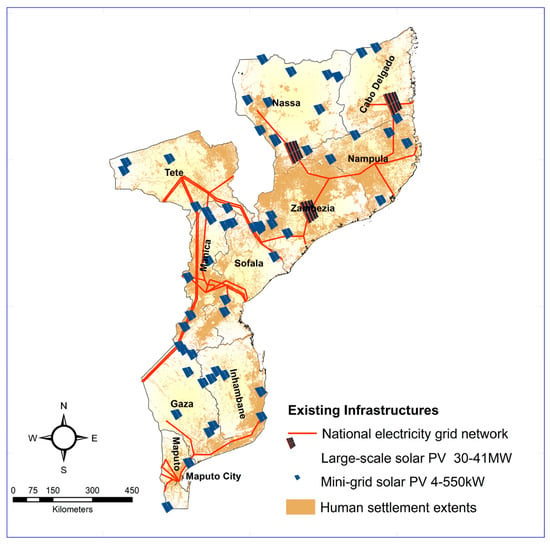
Figure 1
Open AccessArticle
The Impact of Roof Material Profile and Pigmentation on the Performance of Photovoltaic Modules
by
Nosakhare Aigbedion, Francis Njoka and Mathew Munji
Solar 2023, 3(4), 618-637; https://doi.org/10.3390/solar3040033 - 01 Nov 2023
Abstract
►▼
Show Figures
This study combines simulations and experiments to study the heat interactions between various types of roofs and the photovoltaic (PV) modules installed on them. Specifically, the performance of PV modules on a clay roof was compared with their performance on two types of
[...] Read more.
This study combines simulations and experiments to study the heat interactions between various types of roofs and the photovoltaic (PV) modules installed on them. Specifically, the performance of PV modules on a clay roof was compared with their performance on two types of metal roofs, a Box-profile metal roof and an Orientile metal roof, which differ in shape and geometry. Additionally, this study examined the cooling potential of three common metal roof pigments, iron (iii) oxide (Fe2O3), titanium dioxide (TiO2) and basalt, on roof-installed PV modules. An unpigmented roof was also studied for comparison purposes. Model development and simulation were implemented in COMSOL Multiphysics, and the simulation results were validated and compared with field experiments. The maximum open-circuit voltages of the PV installations were found to be 21.096 V for the clay roof, 20.945 V for the Box-profile metal roof and 20.718 V for the Orientile metal roof. This study revealed that the unpigmented roof had higher solar cell temperatures compared to the pigmented models, with temperature gains ranging from 2.2 °C to 2.71 °C. Moreover, the unpigmented model displayed significantly higher surface radiosity than the pigmented models. The performance output of the modules also varied depending on the metal roof sheet shape and geometry, with the Box-profile metal roof yielding better results than the Orientile metal roof sheet. These results indicate that a specific roof pigmentation may have a small impact on a single PV module, but it can become significant in a large array of modules, especially if cooling through natural convection is hindered.
Full article

Figure 1
Open AccessArticle
Automating Quality Control of Irradiance Data with a Comprehensive Analysis for Southern Africa
by
Francisca Muriel Daniel-Durandt and Arnold Johan Rix
Solar 2023, 3(4), 596-617; https://doi.org/10.3390/solar3040032 - 30 Oct 2023
Abstract
►▼
Show Figures
A review of quality control for large irradiance datasets is applied as a case study for the Southern African Universities Radiometric Network (SAURAN) database. The quality control procedure is automated and applied to 24 stations from the database with a total of 848,189
[...] Read more.
A review of quality control for large irradiance datasets is applied as a case study for the Southern African Universities Radiometric Network (SAURAN) database. The quality control procedure is automated and applied to 24 stations from the database with a total of 848,189 hourly datapoints. From this, the individual station’s data quality is also analysed. The assessment validates the automated methodology without the need for a user-based review of the data. The SAURAN database can play a significant role in advancing solar and wind energy; however, the number of offline stations hinders this process. Data scarcity remains an obstacle to these goals, and therefore, recommendations are provided to address this. Recommendations regarding each site’s usability in time-series and discrete applications are made, which provides an overall indication of the SAURAN database’s irradiance measurement quality. Of the 24 measuring stations assessed, eight are recommended, 11 are recommended with cautious use, and five are recommended with extremely cautious use. These recommendations are based on multiple factors, such as whether a dataset has more than one full year of data or is missing minimal datapoints. Further, a study of the irradiance correlation between the stations was conducted. The results indicated groupings of different stations that showed highly correlated irradiance measurements and similar weather patterns. This is useful if a proposed renewable energy power plant, such as PV, falls within a cluster where the data from the SAURAN database can be used as a substitute if no data is available. SAURAN presents an opportunity for Southern Africa to increase its research outputs in solar and wind energy and lessen its dependency on fossil fuel-based energy production.
Full article
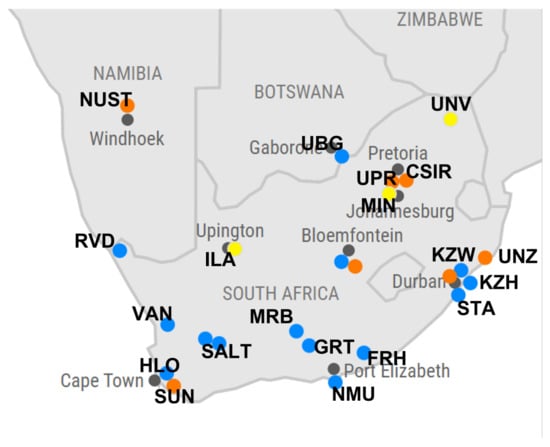
Figure 1
Open AccessReview
Advances on Sb2Se3 Solar Cells Fabricated by Physical Vapor Deposition Techniques
by
Roberto Jakomin, Stefano Rampino, Giulia Spaggiari and Francesco Pattini
Solar 2023, 3(4), 566-595; https://doi.org/10.3390/solar3040031 - 12 Oct 2023
Cited by 1
Abstract
Sb2Se3, as an earth-abundant and low-toxic material, has emerged as one of the most interesting absorbers for clean renewable power generation technologies. Due to its optical properties, especially bandgap and absorption coefficient, the number of papers on Sb2
[...] Read more.
Sb2Se3, as an earth-abundant and low-toxic material, has emerged as one of the most interesting absorbers for clean renewable power generation technologies. Due to its optical properties, especially bandgap and absorption coefficient, the number of papers on Sb2Se3-based solar cells has been constantly increasing in the last ten years, and its power conversion efficiency has raised from 1% in 2014 to 10.57% in 2022. In this review, different Sb2Se3 solar cells’ fabrication technologies based on physical vapor deposition are described and correlated to the texture coefficient (ribbon orientation). Moreover, recent research works of the most promising solar cell configurations with different electron-transporting layers and hole-transporting layers are analyzed with a special emphasis on photovoltaic performances. Furthermore, different Sb2Se3 doping techniques are discussed. All these aspects are considered as new strategies to overcome the Sb2Se3 solar cell’s actual limitations.
Full article
(This article belongs to the Topic Photovoltaic Materials and Devices)
►▼
Show Figures
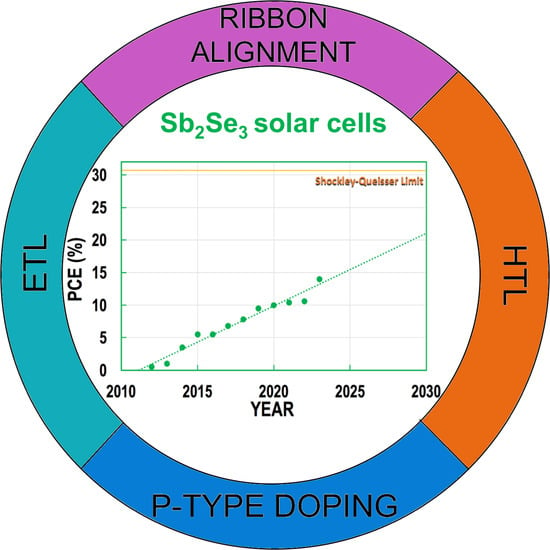
Graphical abstract
Open AccessArticle
Numerical Modeling and Experimental Validation of Heat Transfer Characteristics in Small PTCs with Nonevacuated Receivers
by
Amedeo Ebolese, Domenico Marano, Carlo Copeta, Agatino Bruno and Vincenzo Sabatelli
Solar 2023, 3(4), 544-565; https://doi.org/10.3390/solar3040030 - 12 Oct 2023
Abstract
The development of small-sized parabolic trough collectors (PTCs) for processing heat production at medium temperatures (100–250 °C) represents an interesting approach to increase the utilization of solar thermal technologies in industrial applications. Thus, the development of simplified models to analyze and predict their
[...] Read more.
The development of small-sized parabolic trough collectors (PTCs) for processing heat production at medium temperatures (100–250 °C) represents an interesting approach to increase the utilization of solar thermal technologies in industrial applications. Thus, the development of simplified models to analyze and predict their performance under different operative and climatic conditions is crucial for evaluating the application potential of this low-cost technology. In this paper, we present a numerical method that by combining three-dimensional finite element simulations (implemented with COMSOL Multiphysics software version 6.1) with a one-dimensional analysis (based on a MATLAB script) allows for the theoretical determination of the power output of a small-PTC with a nonevacuated tubular receiver operating at a medium temperature. The finite element model considers both the nonuniformity of the concentrated solar flux on the receiver tube (evaluated using Monte Carlo ray-tracing analysis) and the establishment of natural convection in the air gap between the glass envelope and absorber tube. The model calculates, for several values of direct normal irradiance (DNI) and inlet temperatures, the thermal power transferred to the heat transfer fluid (HTF) per unit length. The data are fitted using the multiple linear regression method, obtaining a function that is then used in a one-dimensional multi-nodal model to estimate the temperatures and the heat gains along the receiver tube. The outputs of the model are the outlet temperature and the total thermal power transferred to the HTF. In order to validate the developed methodology for the assessment of the heat transfer characteristics in the small-PTC with a nonevacuated receiver, an experiment at the ENEA Trisaia—Solar Thermal Collector Testing Laboratory was carried out. This work compares the theoretical data with those acquired through experimentation, obtaining a good agreement, with maximum differences of 0.2% and 3.6% for the outlet temperatures and the power outputs, respectively.
Full article
(This article belongs to the Special Issue Recent Advances in Solar Thermal Energy)
►▼
Show Figures
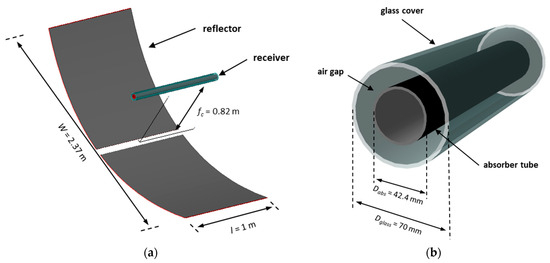
Figure 1
Open AccessArticle
Optimal Sizing and Assessment of Standalone Photovoltaic Systems for Community Health Centers in Mali
by
Abid Ali, Maïté Volatier and Maxime Darnon
Solar 2023, 3(3), 522-543; https://doi.org/10.3390/solar3030029 - 15 Sep 2023
Cited by 1
Abstract
Despite abundant solar resources, Mali has remained one of the least electrified countries in the world. Besides daily life activities and the economy, the shortage of electricity has severely affected the quality of healthcare services in the country. In the absence of electrical
[...] Read more.
Despite abundant solar resources, Mali has remained one of the least electrified countries in the world. Besides daily life activities and the economy, the shortage of electricity has severely affected the quality of healthcare services in the country. In the absence of electrical grids, standalone photovoltaic (PV) systems could be an alternative option in Mali for the electrification of isolated community health centers. However, because standalone PV systems are highly weather-dependent, they must be properly sized according to the local weather conditions. This paper presents the optimal sizing of standalone PV systems for the electrification of community health centers in Mali. The optimization for PV systems was performed for five different locations through simulation and modeling using PVsyst, considering the autonomy of 1 to 3 days and the probability of loss of load for 1 to 5%. Furthermore, for the economic analysis, the levelized cost of electricity (LCOE), payback period and return on investment for the standalone PV systems were calculated. Through the optimization, it was found that the standalone PV systems with PV array sizes ranging from 1650 to 2400 watts, along with 606 Ah battery storage, would be suitable to supply the daily energy demand for community health centers anywhere in the country. Moreover, by only replacing the 606 Ah battery storage with 1212 Ah and 1818 Ah sizes, the PV systems would be able to help and keep the energy reserves for 2 and 3 autonomous days, respectively. Furthermore, the results show that in comparison to a LCOE of 0.94–0.98 USD/kWh for a diesel generator, the LCOE for the standalone PV system would range from 0.23 to 0.46 USD/kWh without discounted rates and from 0.33 to 0.60 USD/kWh if discounted at 6%. In addition to a lower LCOE, the saving of 46–76 tons of CO2 during the project’s lifespan, the short payback periods and high return of investment (ROI) values make standalone PV systems a suitable electrification option for Mali. Considering the total expenses, LCOE, payback period, and ROI, standalone PV systems for community health centers were found to be economically viable in all cases for Mali.
Full article
(This article belongs to the Topic Electrification and Sustainable Energy Systems to Improve Agriculture and Rural Areas)
►▼
Show Figures
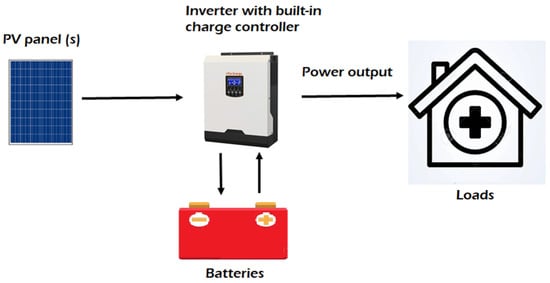
Figure 1
Open AccessReview
Design and Development of a Conceptual Solar Energy Laboratory for District Heating Applications
by
Jaewook Chung, Sreenath Sukumaran, Aleksandr Hlebnikov and Anna Volkova
Solar 2023, 3(3), 504-521; https://doi.org/10.3390/solar3030028 - 06 Sep 2023
Cited by 1
Abstract
►▼
Show Figures
The decarbonization of the district heating (DH) sector is receiving attention worldwide. Solar energy and heat pump technologies are widely considered in existing and new DH networks. There is a need to understand the influence of solar energy on district heating experimentally. However,
[...] Read more.
The decarbonization of the district heating (DH) sector is receiving attention worldwide. Solar energy and heat pump technologies are widely considered in existing and new DH networks. There is a need to understand the influence of solar energy on district heating experimentally. However, only a few university laboratories are focused on district heating aspects. Further, the concept of such laboratories is not adequately disseminated in the scientific literature. The main objective of this paper is to develop a conceptual design of a solar energy laboratory with a focus on district heating systems. The proposed concept forms part of the preliminary study carried out by a research group at the Tallinn University of Technology. First, a brief literature review on solar energy laboratory development is provided. Then, the conceptual design of such a laboratory is presented, along with a case study. Regardless of project size, the main components of a district heating-based solar energy laboratory are solar collectors, thermal energy storage (TES) tanks, and a control system. The proposed laboratory is expected to serve multiple roles, such as a practical laboratory to provide interdisciplinary courses for students, a research and experimental platform for researchers, and a cradle to achieve the campus green initiative. It is roughly estimated that the thermal energy output from the proposed laboratory would meet around 25% of the heat demand of the institutional building during the summer season (May, June, July, and August). It is expected that the present study will be a reference material for the development of innovative energy laboratories in educational institutions.
Full article
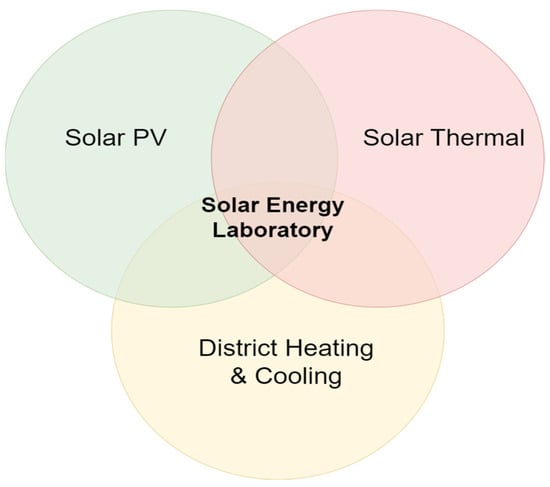
Figure 1
Highly Accessed Articles
Latest Books
E-Mail Alert
News
Topics
Topic in
Energies, Materials, Processes, Solar, Sustainability
Solar Thermal Energy and Photovoltaic Systems, 2nd Volume
Topic Editors: Pedro Dinis Gaspar, Pedro Dinho da Silva, Luís C. PiresDeadline: 31 May 2024
Topic in
Agriculture, Electronics, Energies, Sensors, Solar
Electrification and Sustainable Energy Systems to Improve Agriculture and Rural Areas
Topic Editors: Luis Hernández-Callejo, Miguel-Ángel Muñoz-GarcíaDeadline: 20 June 2024
Topic in
Coatings, Materials, Membranes, Nanomaterials, Solar, Colloids and Interfaces
Advances in Functional Thin Films
Topic Editors: Ricardo Lopez Anton, Jose Maria De Teresa, Sion Federico Olive MéndezDeadline: 30 September 2024
Topic in
Clean Technol., Energies, Materials, Solar, Sustainability
Smart Solar Energy Systems
Topic Editors: Venizelos Efthymiou, Minas PatsalidesDeadline: 15 November 2024

Conferences
Special Issues
Special Issue in
Solar
Developments in Perovskite Solar Cells
Guest Editor: Terry Chien-Jen YangDeadline: 25 April 2024
Special Issue in
Solar
The Forth-Coming Era of Photovoltaic Technologies: Hybrid Organic-Inorganic Solar Cells
Guest Editors: Giuseppe Calogero, Jessica BarichelloDeadline: 24 May 2024
Special Issue in
Solar
Role of Heterojunction in Photovoltaic Devices
Guest Editor: Sadia AmeenDeadline: 30 July 2024

